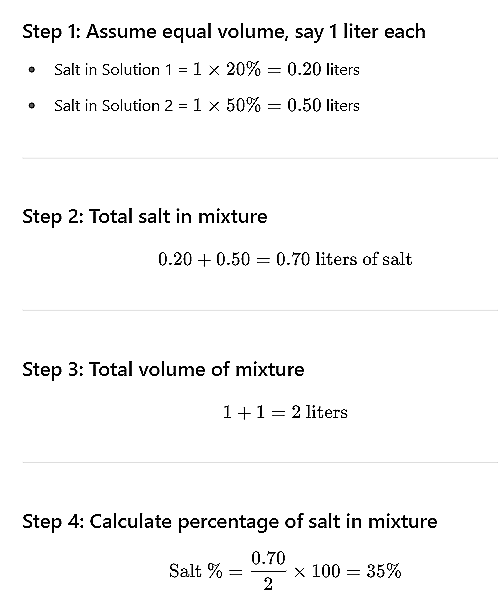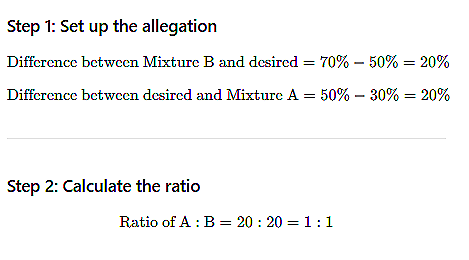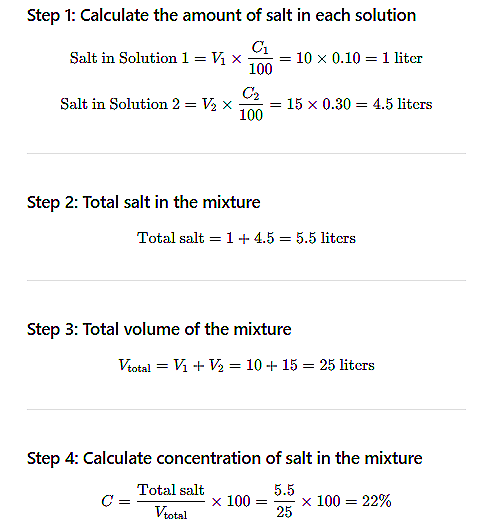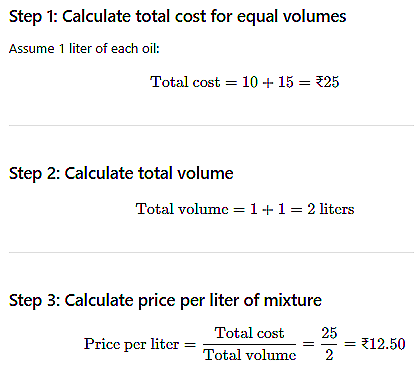|
The Mixture Rule states that when two different mixtures are combined, the overall concentration of a component can be found using the weighted average of the concentrations of the individual mixtures based on their respective quantities. |
Card: 2 / 28 |
|
If a solution contains 20% salt and another solution contains 50% salt, how can you find the percentage of salt in the mixture if you combine equal volumes of both solutions? |
Card: 3 / 28 |
|
A bottle contains 40 liters of a 25% alcohol solution. How much pure alcohol is in the bottle? |
Card: 5 / 28 |
|
To find the amount of pure alcohol, multiply the total volume by the percentage of alcohol: |
Card: 6 / 28 |
|
You have two mixtures: Mixture A has 30% sugar and Mixture B has 70% sugar. How much of each mixture do you need to create a new mixture that is 50% sugar? |
Card: 7 / 28 |
|
If you mix 10 liters of a 10% salt solution with 15 liters of a 30% salt solution, what is the concentration of salt in the resulting mixture? |
Card: 9 / 28 |
|
The Allegation Method is a technique used to determine the ratio in which two or more ingredients at different prices or concentrations must be mixed to achieve a desired concentration. It involves calculating the differences between the concentrations and using those differences to find the ratio. |
Card: 12 / 28 |
|
A mixture contains 30% sugar and 70% water. If you want to make a new mixture with 50% sugar, what should be the ratio of sugar to water? |
Card: 13 / 28 |
 Unlock all Flashcards with EduRev Infinity Plan Starting from @ ₹99 only
|
|
If a company produces a mixture of two oils, one costing ₹10 per liter and the other ₹15 per liter, how do you find the price per liter of a mixture containing equal volumes of both oils? |
Card: 15 / 28 |
|
A 10-liter solution contains 20% acid. If 5 liters of a 40% acid solution is added, what is the new concentration of acid in the mixture? |
Card: 17 / 28 |
|
First, calculate the total acid in the original solution: 10 liters x 20% = 2 liters of acid. |
Card: 18 / 28 |
|
The weighted average allows us to calculate the overall concentration of a mixture by factoring in the proportions of the individual components. It simplifies the process of finding the final concentration based on the individual concentrations and their quantities. |
Card: 20 / 28 |
|
What is the formula for calculating the total amount of a substance in a mixture? |
Card: 21 / 28 |
|
The total amount of a substance in a mixture can be calculated using the formula: Total Amount = Volume1 x Concentration1 + Volume2 x Concentration2 + ... + VolumeN x ConcentrationN |
Card: 22 / 28 |
|
If a mixture consists of 30% chemical A and 70% chemical B, how much of chemical A is in 200 liters of the mixture? |
Card: 23 / 28 |
|
To find the amount of chemical A, multiply the total volume by the concentration of chemical A: |
Card: 24 / 28 |
|
When mixing two liquids of different densities, how do you determine the density of the resulting mixture? |
Card: 25 / 28 |
|
The density of the resulting mixture can be calculated using the formula: |
Card: 26 / 28 |
|
If you have a 25% sugar solution and you want to dilute it to a 10% solution, how do you find the amount of water to add? |
Card: 27 / 28 |
|
Let x be the amount of water to add. The equation is: |
Card: 28 / 28 |










 where Mass is determined by multiplying density by volume for each liquid.
where Mass is determined by multiplying density by volume for each liquid. Solving will give you the necessary amount of water to achieve the desired concentration.
Solving will give you the necessary amount of water to achieve the desired concentration.



















